WordPress doesn’t make it easy to change your WordPress username. But it is possible.
There’s no built-in feature for changing a WordPress username. In part, this is because WordPress doesn’t want you to. Changing your username incorrectly could lead to you being locked out of your website.
Still, there are reasons you could want to change your WordPress username. Common reasons you could want to change your username include:
- A malicious user has compromised your current login information
- Your login information is attached to a now-defunct email address
- You are taking over the website from another person
- Your username has information you don’t want revealed, such as your real name
Below, we’ll discuss several methods of changing your WordPress username, ranging from beginner to advanced.
Before You Get Started…
Before making any major changes to your website, it’s a good general best practice to back it up. If anything goes wrong, you can restore your information. Use a WordPress backup plugin to keep a backup of your installation.
But be aware: Login issues can be finicky. If you update just the files and content of your WordPress site, for instance, you could still be locked out of your WordPress installation and unable to restore it. Be cautious and take things slowly when changing your login information.
How to Change Your WordPress Username (Beginner Method)
To change your username with this method, you’ll create an entirely new WordPress user, transfer your privileges, and delete the account you don’t want. While this may seem circuitous, it’s the easiest and most straightforward method of changing users. This is the most recommended method because fewer things can go wrong.
1. Add a New WordPress User
Start by adding a new WordPress user. This user should have the username and password that you want to have, as it will be replacing your current user account.
Log into the WP Admin Dashboard with your current credentials. Navigate to the Users section.
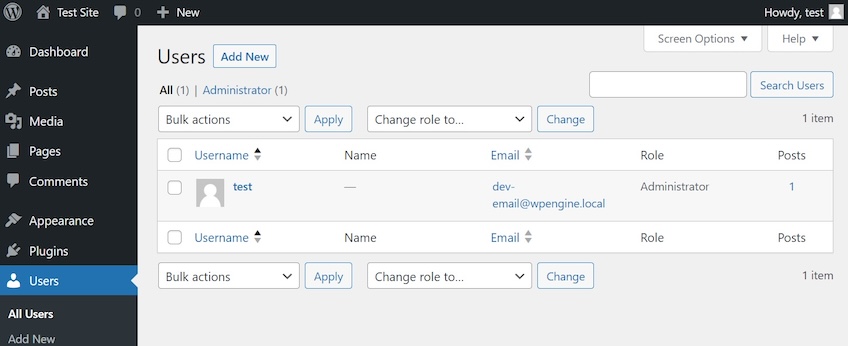
Above, you can see that we have a single Administrator named “Test.” And perhaps we don’t want to be named “Test” anymore!
Click Add New. We are going to add a new user named Administrator. You will be required to put in an email address.
It’s extremely important you put in the correct email address to create and maintain access to the account. This email address is what’s used when you do things like request a password change.
You can either set your password manually or have a strong password generated for you.
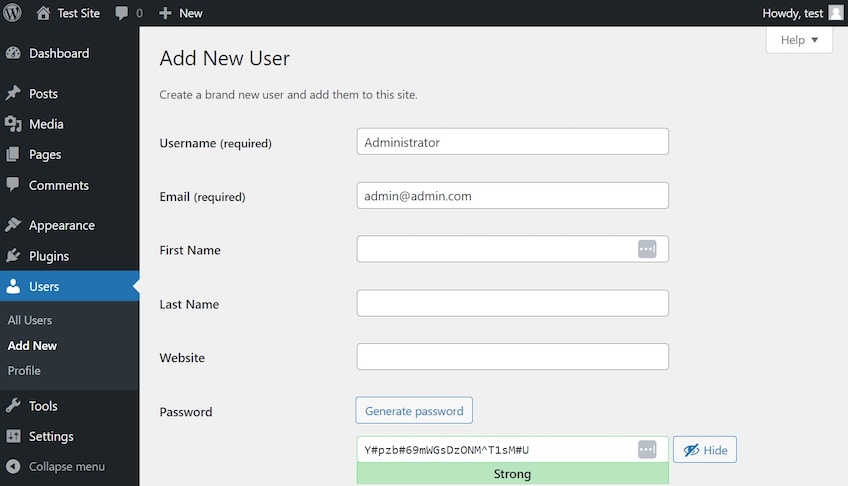
Finally, at the bottom, you can select the user’s Role. You will set this to Administrator.
Now, click Add New User. If you’ve filled in all the required information, your new user will be saved.
2. Transfer to Your New Account
Back at the User panel, you will likely see that you can delete your new user but not your current user. But that’s because you’re still logged in as that user. Since you’re both administrators, you don’t need to transfer any permissions. But you still should delete the old account. Having multiple administrator accounts can be a security risk.
Log out of your old account and log into the new account. Once you’ve transferred accounts, you can delete the old one. This is also a way to test that you can access the new account before you delete the old one.
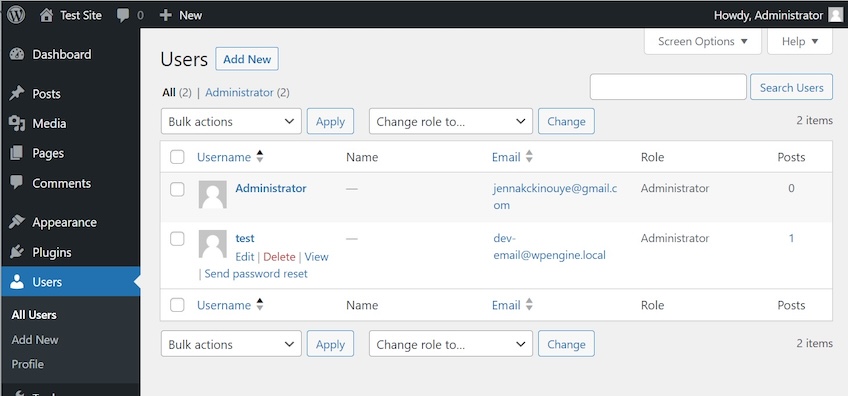
3. Delete the Old WordPress User
Back in the User panel, click Delete under the user account you want to delete. It will show up in red.
You will be brought to a screen that asks you what to do with the content that you’ve published thus far. You can delete your content (you probably do not want to do this) or attribute all your current content to your new account (this is probably the option you want).
Select the option you want and then click Confirm Deletion.
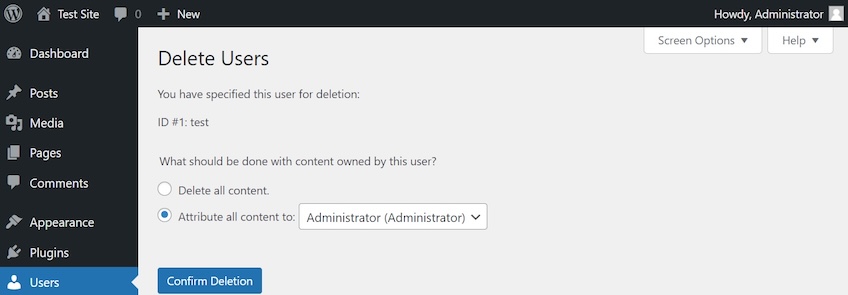
You’ve successfully changed your username by creating a new user and deleting the old one. If you selected the “Attribute all content” option, all your posts, pages, and comments will now be attributed to your new user account.
How to Change Your WordPress Username with phpMyAdmin (Advanced Method)
When you use WordPress, all your data is stored in a type of database called a MySQL database. You can change your WordPress username directly by using a tool called phpMyAdmin. If you’re an advanced user, this method is more direct. If you aren’t an advanced user, this method can be extremely risky.
Important: Before modifying these settings, log out of your WP Admin Dashboard. If you don’t, you could still have a session attached to your old username when your username changes, making it difficult to log back in.
There are a few things you should know about phpMyAdmin:
- phpMyAdmin is a database management utility provided by some, but not all, web hosts. Your web hosting service may not offer phpMyAdmin.
- phpMyAdmin is accessible through your web hosting service’s control panel, not through WordPress. So, you will need to log into your host to access phpMyAdmin.
- phpMyAdmin lets you directly modify your database, which is dangerous.
It’s easy to make a mistake in phpMyAdmin. Further, a single mistake could cause your website to go down. Always backup your website before using phpMyAdmin. Consider not using it at all unless you have experience with databases.
1. Access phpMyAdmin
Here are instructions for how to get to phpMyAdmin using some popular web hosts for WordPress:
- Bluehost: Managing your database with phpMyAdmin
- GoDaddy: Open phpMyAdmin
- HostGator: HostGator | phpMyAdmin Support
- Hostinger: How to Access phpMyAdmin at Hostinger
Once you get into your phpMyAdmin console, you will see why it’s such a complex operation.
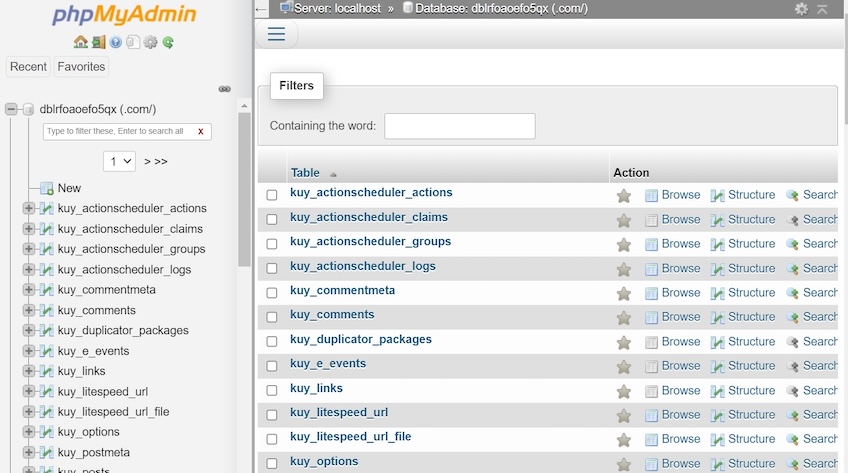
Here, we see a list of tables. Each table contains information about WordPress. For instance, the _comments database includes comments made on posts and pages.
WordPress generally installs with a random series of characters (in this case “kuy_”) before the table names. This is to maintain additional security. You will see a very long list of tables in your database, but you only need to concern yourself with one: the table that ends with “_users.”
2. Update Your User Information
Click on the _users table, and you will see your user information. Click on Edit to edit your old user account.
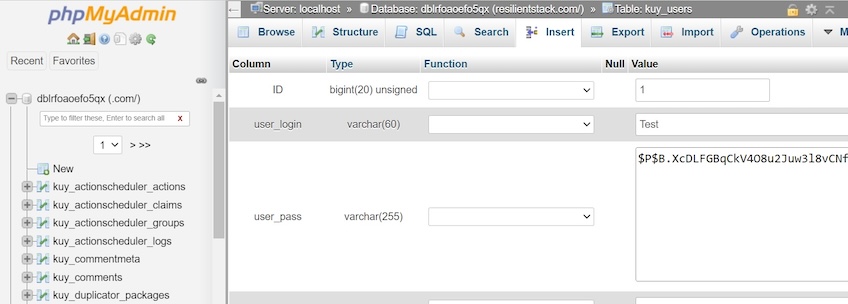
Important: Never try to update your user_pass in this fashion. Your password is encrypted, so manipulating it in the database won’t work as expected.
Update the user_login information (“Test” above) with your new username (such as “Administrator”). Scroll down and Save your user record. If everything worked correctly, you should now be able to log in with your new name.
Note: Instead of doing any of the above, you could also go to SQL and run the query: “update [users_table] set user_login = ‘[new_user_name]’ where user_login = ‘[old_user_name]’” This would run SQL code that would update your login information. But it’s not advised if you are not an advanced user.
How to Change Your WordPress Username with a Plugin (Alternative Method)
Maybe you don’t want to go through the hassle of messing with user accounts, but you also don’t want to risk destroying your database. There’s a third option: a plugin.
Plugins like the Easy Username Updater will change your username for you, but you have to be selective over the plugins you use. Whenever you look at plugins for WordPress, pay attention to the ratings and reviews. Use a plugin that is reviewed highly and has more than a few ratings.
1. Install a Plugin
To install the plugin, go to Plugins -> Add New. Search for “Easy Username Updater,” and click on Install Now and then Activate.
Once the plugin has been activated, you will see an additional option under Users called Username Updater.
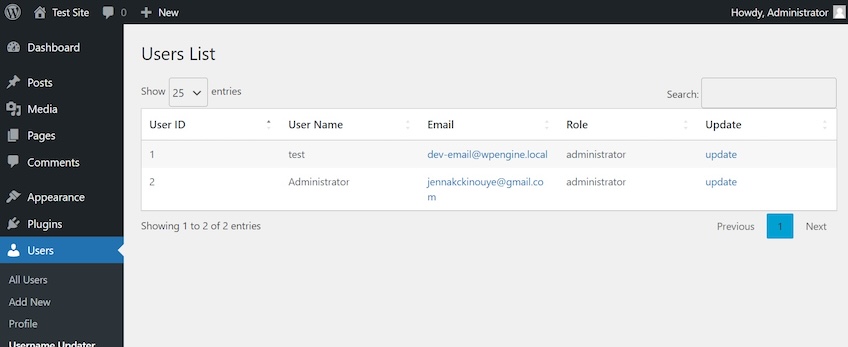
2. Update Your User Information
Click on Update, and you can change the name of any user without having to create a new user or go into the database. You can then safely deactivate and uninstall the plugin if you don’t need to change any other usernames.
Note: It’s a good general practice to delete plugins that you don’t have in use.
A User By Any Other Name
You don’t always need to change your username.
Changing your username is important if you want to change the name that you use to log in. But if you want to change your display name (the name people see on your posts and comments), you can do that without changing your login name.
To change your display name, go to Users -> All Users. Select your user account.
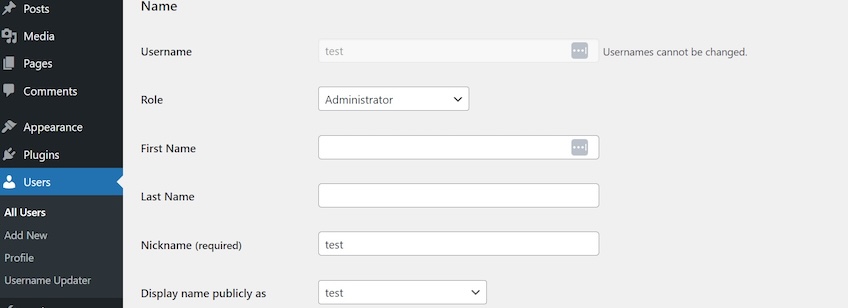
Under the Name section, there are various options for displaying your name. You can set a nickname for your account, and you can set Display name publicly as to your username or your nickname.
This may be an easier solution if you simply want to control the name your readers see on your website.
Common Mistakes When Changing Your Username
Your username controls how you access your site. So, some things can complicate your access.
Using a WordPress.com Account
Some people don’t log directly into their WordPress site. If you built your WordPress blog through WordPress.com or used a WordPress.com login, you need to administer your username and other credentials through WordPress.com. If you don’t log into your website directly but instead login through WordPress.com or Jetpack, this is likely the case.
Using the Wrong Email Address
There are only a few required components when creating a new user: username, email address, password, and role. If you don’t use a real email address, you won’t be able to reset your password later if you need to.
Forgetting Other Plugins
Some plugins change the default authentication process of WordPress. Some plugins let you log in with Google or Facebook. Other plugins just let you use your email address as your username. If you have a plugin that changes authentication, you can’t change your username like this—you will need to go through the plugin itself.
Locking Yourself Out
What happens if you change your username, but there’s a typo? Once logged out, you may not be able to log back in. If this is the case, you may need to use phpMyAdmin (as described above) to navigate to the _users table. There, you will be able to see your username without editing anything.
Managing Your WordPress Website
User management is an important aspect of WordPress account safety. To ensure that your site remains secure:
- Always deactivate any users that aren’t in use.
- Generate complex, unique passwords.
- Change your password periodically.
- Only give users as much permission as they need.
Once you have your login information sorted, you can start building your new WordPress site.
